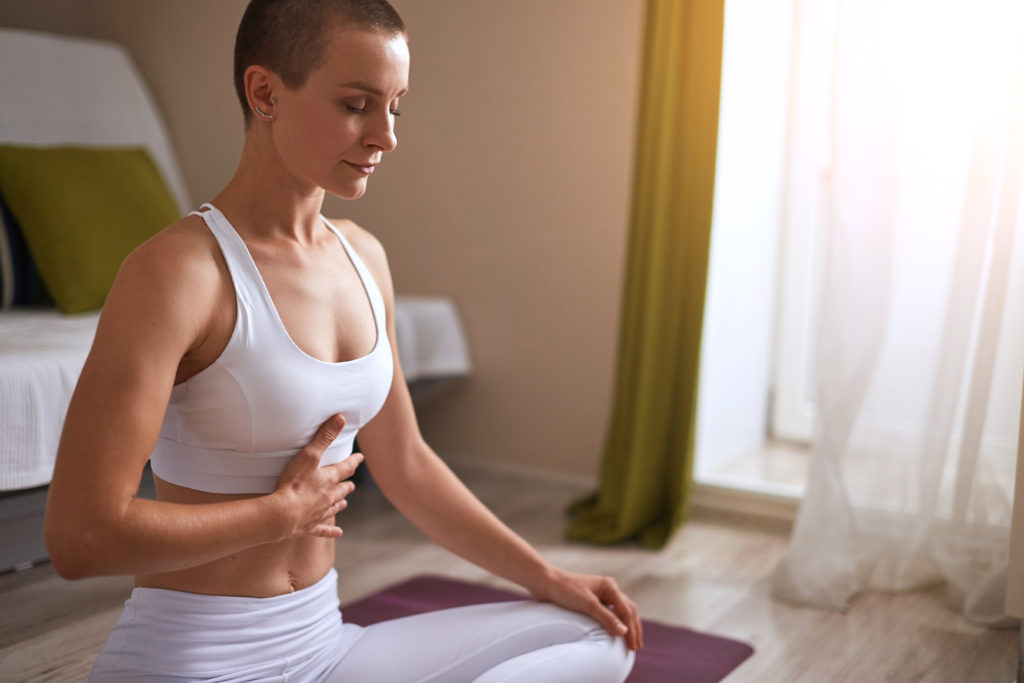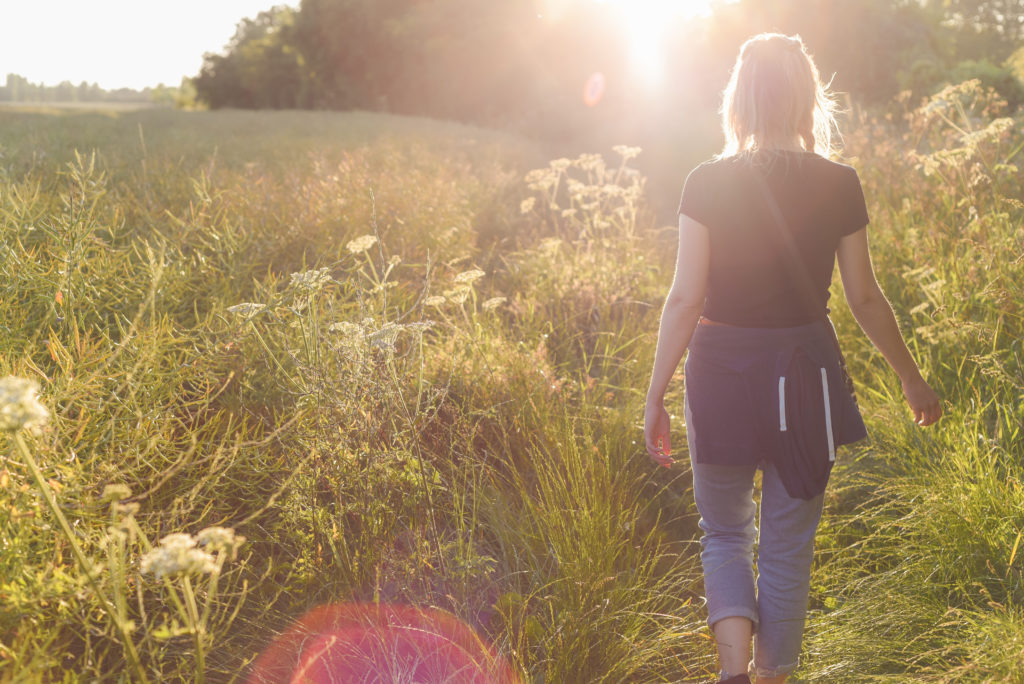The way we breathe has plenty of impact on the way we live. Shallow, choppy breathing translates to anxious thoughts and fidgeting. Steady, consistent deep breathing keeps us grounded and calm. This parallelism feels intuitive.
Research shows, however, that the way we breathe also informs how we move, as well as how we carry ourselves throughout the day.
Breathing enhances high-level performance, acceleration, deceleration, power, speed, precision, and stabilization of the core. It can reinforce proper body mechanics that put less stress on the body as we move.

How Do We Breathe?
Simply put, we breathe by inhaling and exhaling air. The diaphragm is the primary muscle activated during the inhalation. It contracts and moves downward to create space in the chest cavity for the lungs to expand. The intercostal muscles – those between our ribs – assist too by elevating the rib cage, allowing more air into the lungs. In addition, muscles like the sternocleidomastoid, serratus anterior, and pectoralis minor increase the speed and range of the movement of the ribs.
In exhalation, the diaphragm moves upward and the chest wall muscles relax. This causes the chest cavity to become smaller and to push air out of the respiratory system through the nose or the mouth.
What Is The Respiratory System?
The respiratory system is a network of organs and tissues that help us breathe. It includes the nose and nasal cavity, the pharynx, the larynx, the trachea, and lastly the bronchi and their smaller branches, the bronchioles, and the lungs, which contain the alveoli.
The respiratory system is a supplier of oxygen, an eliminator of carbon dioxide and host of passageways designed to purify, humidify, and warm incoming air.
What Are Some Factors That Affect Breathing Rate?
Breathing rates can vary with age, weight, fitness level, and general health. The average breathing rate is 12-18 breaths per minute.
The breathing rate can be affected by sudden or chronic pain that can activate the section of the nervous system that governs the bodily systems (including the breathing and heart rate, and body temperature). Furthermore, chronic stress and strong emotions can impair and increase breathing rate. An increased breathing rate in turn also increases our autonomic nervous system’s sympathetic activity – exacerbating stress. What’s even more wild is that research shows that poor posture contributes to breathing pattern dysfunction.
The way we breathe can affect the way we carry ourselves, but the ways in which we carry ourselves can also greatly inform our breathing habits. Where to start? Slow deep breathing.

How Does Deep Breath Relate To Posture And Movement?
As mentioned before, breathing expands the rib cage which creates better mobility and more space in the spine, pelvic girdle, shoulders, and hips. Furthermore, breathing activates the core which incorporates better control through each movement.
We know that deep breathing is also understood as abdominal or belly breathing. This is a slow and deep inhalation through the nose, and a slow exhalation out of the nose. This type of breathing offers a myriad of benefits, including a reduction in stress and a lowering of the blood pressure.
Unfortunately, we often forget that deep breathing is impacted by the pace of our lives, and the types of work environment we inhabit. Without attention to that slow and deep breath, many of us are, amidst chronic stress, conditioned to take quick and shallow breaths which weakens the respiratory muscles, and despite breathing “more”, deprives us of quality, oxygen-rich breaths. It also creates tension in the upper body, leading to an alteration in posture and in turn undermine a variety of body functions.
For example, poor posture while sitting on the computer, including rounded shoulders and a forward head posture, increases the tension of the muscles around the chest which then restricts the rib cage to expand freely. The result is a rapid and shallow breath. If you’re reading this at your computer now, perhaps take a second to notice, and readjust both your posture, rolling your shoulders back and stacking your head over your spine – and allowing your breath to gently slow.

How Can I Deepen My Breath?
While you may regularly sit at your desk with rounded shoulders and a faster-than-necessary breath rate, for now, let’s focus on two breathing techniques that can slow the rate of the breath. Both of these are familiarly practiced in yoga. But don’t worry if your downward dog is out of practice, you can do this at your desk right now!
The first is ujjayi, which is also known as ocean breath, victorious breath, or even Darth Vader breath. The benefits of this breathing technique include the concentration and direction of the breath through a powerful focus. Additionally, it increases oxygen consumption and calms the fight or flight response in order to promote relaxation. This breath is practiced by inhaling through the nostrils, feeling a gentle activation of the throat, interoceptively felt as a throat-centric smile. You should hear a gentle ocean quality as you inhale, the belly will swell, and the diaphragm will move downward – the shoulders will not move. On the exhale, you’ll maintain that sensation. of the throat smiling, allowing now the diaphragm to release back into place, the belly button may gently pull towards the spine, and the ribs come in towards one another.
The second technique is Nadi Shodhana, which is also called alternate nostril breathing or channel-cleaning breath. Research teaches us that this breathing technique reduces heart rate, stress and anxiety. You can learn more about this practice here, with this step-by-step guide.
(Note: Please always ensure that you are breathing enough, and do end the practice if you feel dizzy or lightheaded.)
Breathe Deep, Move Better!
Understanding the connection between how we breathe and how we move our bodies is an essential part of the “why” behind why we practice deeper breathing. How our body is supported, and how we breathe are intimately connected, and one cannot be supported without the other. But if you’re looking to start somewhere, starting with the breath is always a great place to begin.
Many of us know that deep breathing can be beneficial, but the science behind those benefits is likely going to be what helps us create changes in the way we breathe. Committing to fine-tuning our habits around the pacing and depths of our inhales and exhales will ultimately set up our bodies to be happy and healthy.
Breathe deep, move better!
Bianca, OTD
Sources
Belleza (2021). Respiratory System, Anatomy and Physiology. Nurseslab. https://nurseslabs.com/respiratory-system/
Araujo, Laura. “Nadi Shodhana: Is the Ancient Practice Just Woo – or Is It Key to Re-Balancing, and Revitalizing? for Scientists, This New Study Reveals the Unexpected.” The MAPS Institute, 24 Mar. 2022, https://themapsinstitute.com/nadi-shodhana-is-this-ancient-practice-just-woo-or-is-it-key-to-re-balancing-calming-and-revitalizing/.
Healthline (2017). Breathe deeper to improve health and posture. Healthline. https://www.healthline.com/health/breathe-deeper-improve-health-and-posture
Araujo, L. (2022). Finding Comfort in Discomfort: A Meditation On Change. The MAPS Institute. https://themapsinstitute.com/navigating-the-unknown-a-meditation-on-change-2/
Marcin, J. (2020). Breathe deeper to improve health and posture. Healthline. https://www.healthline.com/health/breathe-deeper-improve-health-and-posture
Hagins, M. et al. (2011). Individuals with low back pain breathe differently than healthy individuals during a lifting task. Journal of Orthopaedic & Sports Physical Therapy, 41(3), 141-148. https://www.jospt.org/doi/10.2519/jospt.2011.3437
Telles S, Desiraju T. (1991). Oxygen consumption during pranayamic type of very slow-rate breathing. Indian J Med Res. 1991;94:357-363. https://pubmed.ncbi.nlm.nih.gov/1794892/
Keen, A. (2021). This is the Time to Take Yoga Back to Its Original Intentions. The MAPS Institute. https://themapsinstitute.com/taking-yoga-back-to-its-original-intentions/
Saoji AA, Raghavendra BR, Manjunath NK. (2018). Effects of yogic breath regulation: A narrative review of scientific evidence. Journal of Ayurveda and Integrative Medicine 2019;10(1):50-58. doi:10.1016/j.jaim.2017.07.008. https://pubmed.ncbi.nlm.nih.gov/29395894/
Pradeep Kumar Pal, Mishra VN, Awasthi HH. (2016) A scientific study: Regulation of autonomic nervous system through slow breath pranayama. Journal of AYUSH: Ayurveda, Yoga, Unani, Siddha and Homeopathy. 2016; 5(3): 23–28p. http://med.stmjournals.com/index.php?journal=AYUSH&page=article&op=view&path%5B%5D=1147
YJ Editors (2007). Channel-Cleaning Breath. Yoga Journal. https://www.yogajournal.com/poses/types/pranayama/channel-cleaning-breath/
